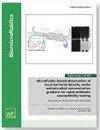微流体设备中的微混合:基础、设计和制造
IF 2.6
4区 工程技术
Q2 BIOCHEMICAL RESEARCH METHODS
引用次数: 0
摘要
作为微流控芯片研究领域的热点之一,微搅拌器因其体积小、响应速度快、试剂消耗低等特点,已被广泛应用于化学、生物和医学领域。然而,在低雷诺数条件下,流体运动主要依靠分子在层流条件下的扩散运动。层流的不利影响导致微通道中的流体难以实现快速有效的混合。因此,有必要通过一些外部手段来加强流体混合。本文根据微搅拌器中有无外力作用,综述了被动式(T 型、Y 型、阻塞式、蛇形、三维)和主动式(声、电、压、热、磁场)微搅拌器的分类和混合原理,并简要讨论了各类微搅拌器的一些实验和应用。最后,总结了微搅拌器的未来发展趋势。本文章由计算机程序翻译,如有差异,请以英文原文为准。
Micromixing within microfluidic devices: Fundamentals, design, and fabrication
As one of the hot spots in the field of microfluidic chip research, micromixers have been widely used in chemistry, biology, and medicine due to their small size, fast response time, and low reagent consumption. However, at low Reynolds numbers, the fluid motion relies mainly on the diffusive motion of molecules under laminar flow conditions. The detrimental effect of laminar flow leads to difficulties in achieving rapid and efficient mixing of fluids in microchannels. Therefore, it is necessary to enhance fluid mixing by employing some external means. In this paper, the classification and mixing principles of passive (T-type, Y-type, obstructed, serpentine, three-dimensional) and active (acoustic, electric, pressure, thermal, magnetic field) micromixers are reviewed based on the presence or absence of external forces in the micromixers, and some experiments and applications of each type of micromixer are briefly discussed. Finally, the future development trends of micromixers are summarized.
求助全文
通过发布文献求助,成功后即可免费获取论文全文。
去求助
来源期刊

Biomicrofluidics
生物-纳米科技
CiteScore
5.80
自引率
3.10%
发文量
68
审稿时长
1.3 months
期刊介绍:
Biomicrofluidics (BMF) is an online-only journal published by AIP Publishing to rapidly disseminate research in fundamental physicochemical mechanisms associated with microfluidic and nanofluidic phenomena. BMF also publishes research in unique microfluidic and nanofluidic techniques for diagnostic, medical, biological, pharmaceutical, environmental, and chemical applications.
BMF offers quick publication, multimedia capability, and worldwide circulation among academic, national, and industrial laboratories. With a primary focus on high-quality original research articles, BMF also organizes special sections that help explain and define specific challenges unique to the interdisciplinary field of biomicrofluidics.
Microfluidic and nanofluidic actuation (electrokinetics, acoustofluidics, optofluidics, capillary)
Liquid Biopsy (microRNA profiling, circulating tumor cell isolation, exosome isolation, circulating tumor DNA quantification)
Cell sorting, manipulation, and transfection (di/electrophoresis, magnetic beads, optical traps, electroporation)
Molecular Separation and Concentration (isotachophoresis, concentration polarization, di/electrophoresis, magnetic beads, nanoparticles)
Cell culture and analysis(single cell assays, stimuli response, stem cell transfection)
Genomic and proteomic analysis (rapid gene sequencing, DNA/protein/carbohydrate arrays)
Biosensors (immuno-assay, nucleic acid fluorescent assay, colorimetric assay, enzyme amplification, plasmonic and Raman nano-reporter, molecular beacon, FRET, aptamer, nanopore, optical fibers)
Biophysical transport and characterization (DNA, single protein, ion channel and membrane dynamics, cell motility and communication mechanisms, electrophysiology, patch clamping). Etc...
 求助内容:
求助内容: 应助结果提醒方式:
应助结果提醒方式:


